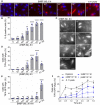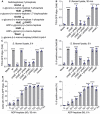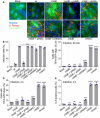ADP-heptose is a newly identified pathogen-associated molecular pattern of Shigella flexneri
- PMID: 30455202
- PMCID: PMC6280651
- DOI: 10.15252/embr.201846943
ADP-heptose is a newly identified pathogen-associated molecular pattern of Shigella flexneri
Abstract
During an infection, the detection of pathogens is mediated through the interactions between pathogen-associated molecular patterns (PAMPs) and pathogen recognition receptors. β-Heptose 1,7-bisphosphate (βHBP), an intermediate of the lipopolysaccharide (LPS) biosynthesis pathway, was recently identified as a bacterial PAMP. It was reported that βHBP sensing leads to oligomerization of TIFA proteins, a mechanism controlling NF-κB activation and pro-inflammatory gene expression. Here, we compare the ability of chemically synthesized βHBP and Shigella flexneri lysate to induce TIFA oligomerization in epithelial cells. We find that, unlike bacterial lysate, βHBP fails to initiate rapid TIFA oligomerization. It only induces delayed signaling, suggesting that βHBP must be processed intracellularly to trigger inflammation. Gene deletion and complementation analysis of the LPS biosynthesis pathway revealed that ADP-heptose is the bacterial metabolite responsible for rapid TIFA oligomerization. ADP-heptose sensing occurs down to 10-10 M. During S. flexneri infection, it results in cytokine production, a process dependent on the kinase ALPK1. Altogether, our results rule out a major role of βHBP in S. flexneri infection and identify ADP-heptose as a new bacterial PAMP.
Keywords: ADP‐heptose; ALPK1; HBP; TIFA; pathogen recognition.
© 2018 The Authors.
Figures



IL‐8 production after 6 h of treatment with digitonin and βHBP at indicated concentrations or digitonin and wt Shigella flexneri lysate in HeLa cells (Hoechst in blue, IL‐8 in red).
Quantification of IL‐8 as shown in (A). Data correspond to the mean ± SD of three independent experiments.
TIFA oligomerization at 6 h in TIFA‐GFP‐expressing HeLa cells treated as in (A).
Quantification of TIFA oligomerization as shown in (C). Data correspond to the mean ± SD of three independent experiments.
TIFA oligomerization at 30 min in cells treated as in (A). Data correspond to the mean ± SD of four independent experiments.
Kinetics of TIFA‐GFP oligomerization upon treatment with digitonin alone or in combination with βHBP or Shigella flexneri lysate. Data correspond to the mean ± SEM of four independent experiments.

LPS biosynthesis pathway. HldA and HldC from Neisseria meningitidis are in brackets.
TIFA‐GFP oligomerization at 30 min in HeLa cells treated with digitonin (mock) or digitonin and a lysate from indicated Shigella flexneri strains (pHldA/C means plasmid‐encoded HldA and HldC).
TIFA‐GFP oligomerization at 6 h in cells treated as in (B).
IL‐8 production at 6 h in cells was treated as in (C).
TIFA‐GFP oligomerization in cells treated for 30 min with digitonin alone, digitonin and wild‐type S. flexneri lysate, or digitonin and ADP‐L‐β‐
d ‐heptose at indicated concentrations.IL‐8 production after 6 h in cells treated as in (E).


Representative images of the formation of TIFA oligomers in HeLa cells infected for 30 min with dsRed‐expressing wt or indicated mutants of S. flexneri (MOI 50). pHldA/C means plasmid‐encoded HldA and HldC. Fluorescence intensity was adjusted between strains to optimize visualization of bacteria. Scale bar, 20 μm.
Infectivity of indicated S. flexneri strains.
TIFA‐GFP oligomerization after 30 min of infection with selected mutants of the LPS biosynthesis pathway (MOI 10).
TIFA‐GFP oligomerization after 4 h of infection with the S. flexneri mutants shown in (C).
IL‐8 production 4 h postinfection (MOI 5).


ADP‐heptose‐induced TIFA‐GFP oligomerization depends on ALPK1. After siRNA transfection, HeLa cells were transfected with empty pCMV or pCMV‐ALPK1 as indicated. They were then infected with wt Shigella flexneri (MOI 10) or treated with digitonin and ADP‐heptose (10−5 M) for 30 min. As control, cells were left untreated (mock) or treated with digitonin.
ADP‐heptose‐induced cytokine secretion is ALPK1‐dependent. HeLa cells were transfected with control or ALPK1‐targeting siRNAs and infected with wt S. flexneri (MOI 2) or treated with ADP‐heptose (10−5 M). As control, cells were left untreated (mock) or treated with digitonin. Cytokines were measured in cell culture supernatants after 8 h.
References
-
- Gaudet RG, Sintsova A, Buckwalter CM, Leung N, Cochrane A, Li J, Cox AD, Moffat J, Gray‐Owen SD (2015) INNATE IMMUNITY. Cytosolic detection of the bacterial metabolite HBP activates TIFA‐dependent innate immunity. Science 348: 1251–1255 - PubMed
-
- Tettelin H, Saunders NJ, Heidelberg J, Jeffries AC, Nelson KE, Eisen JA, Ketchum KA, Hood DW, Peden JF, Dodson RJ et al (2000) Complete genome sequence of Neisseria meningitidis serogroup B strain MC58. Science 287: 1809–1815 - PubMed
-
- Taylor PL, Sugiman‐Marangos S, Zhang K, Valvano MA, Wright GD, Junop MS (2010) Structural and kinetic characterization of the LPS biosynthetic enzyme D‐alpha, beta‐D‐heptose‐1,7‐bisphosphate phosphatase (GmhB) from Escherichia coli . Biochemistry 49: 1033–1041 - PubMed
Publication types
MeSH terms
Substances
Grants and funding
LinkOut - more resources
Full Text Sources
Molecular Biology Databases
Miscellaneous

